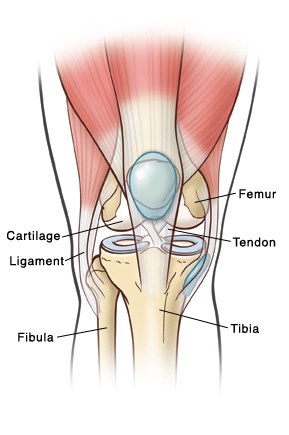Knee Sprain

A sprain is an injury to the ligaments or capsule that holds a joint together. There are no broken bones. Most sprains take 3 to 6 weeks to heal. If it's a severe sprain where the ligament is completely torn, it can take months to recover.
Most knee sprains are treated with a splint, knee immobilizer brace, or elastic wrap for support. Severe sprains may rarely require surgery.
Home care
-
Stay off the injured leg as much as possible until you can walk on it without pain. If you have a lot of pain with walking, crutches or a walker may be prescribed. (These can be rented or purchased at many pharmacies and surgical or orthopedic supply stores). Follow your healthcare provider's advice about when to begin putting weight on that leg.
-
Keep your leg raised (elevated) to reduce pain and swelling. When sleeping, place a pillow under the injured leg. When sitting, support the injured leg so it's above heart level. This is very important during the first 48 hours.
-
Apply an ice pack over the injured area for 15 to 20 minutes every 2 to 3 hours. You should do this for the first 24 to 48 hours. To make an ice pack, put ice cubes in a plastic bag that seals at the top. Wrap the bag in a thin towel. Continue to use ice packs to ease pain and swelling as needed. As the ice melts, be careful to avoid getting your wrap, splint, or cast wet. After 48 to 72 hours or as directed by your healthcare provider, apply heat (warm shower or warm bath) for 15 to 20 minutes several times a day, or alternate ice and heat. You can place the ice pack directly over the splint. If you have to wear a hook-and-loop knee brace, you can open it to apply the ice pack, or heat, directly to the knee. Never put ice directly on the skin. Always wrap the ice in a towel or other type of cloth.
-
You may use over-the-counter pain medicine to control pain, unless another pain medicine was prescribed. If you have chronic liver or kidney disease, ever had a stomach ulcer or gastrointestinal bleeding, or take a blood thinner, talk with your healthcare provider before using these medicines.
-
If you were given a splint, keep it completely dry at all times. Bathe with your splint out of the water, protected with 2 large plastic bags, sealed with rubber bands or tape at the top end. If a fiberglass splint gets wet, you can dry it with a hair dryer set to cool. If you have a hook-and-loop knee brace, you can remove this to bathe, unless told otherwise.
Follow-up care
Follow up with your doctor, or as advised. Any X-rays you had today don’t show any broken bones, breaks, or fractures. Sometimes fractures don’t show up on the first X-ray. Bruises and sprains can sometimes hurt as much as a fracture. These injuries can take time to heal completely. If your symptoms don’t improve or they get worse, talk with your doctor. You may need a repeat X-ray. If X-rays were taken, you will be told of any new findings that may affect your care.
Call 911
Call 911 if you have:
-
Shortness of breath
-
Chest pain
When to get medical advice
Call your healthcare provider right away if any of these occur:
-
The splint or knee immobilizer brace becomes wet or soft
-
The fiberglass cast or splint stays wet for more than 24 hours
-
Pain or swelling get worse
-
The injured leg or toes become cold, blue, numb, or tingly
Online Medical Reviewer:
Louise Cunningham RN BSN
Online Medical Reviewer:
Raymond Turley Jr PA-C
Online Medical Reviewer:
Thomas N Joseph MD
Date Last Reviewed:
2/1/2022
© 2000-2024 The StayWell Company, LLC. All rights reserved. This information is not intended as a substitute for professional medical care. Always follow your healthcare professional's instructions.